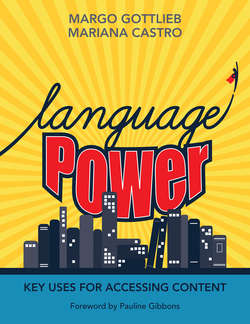Читать книгу Language Power - Margo Gottlieb - Страница 36
На сайте Литреса книга снята с продажи.
Discuss
ОглавлениеDiscuss, the D in DARE, highlights the importance of oral language development and social interaction in learning, to reinforce its role in literacy development, and to acknowledge its presence in academic content standards. Research has shown that proficiency in oral language provides children with a vital tool for thought and that structured oral language supports students’ thinking processes (Bruner, 1983). As shown in Figure 1.5, oral discussions in classrooms may occur among students or between students and teachers around specific tasks.
Participation in these tasks alone is not enough to develop students’ oral language. It is critical that educators make explicit the norms of working with partners or small groups. For some ELLs, for example, having access to the language needed to agree or disagree with others or to elaborate on others’ ideas is a precursor to their participation in English-medium classrooms.
Figure 1.5 Examples of Oral Discussions
Promoting oral language development requires designing instruction around engaging content. This can be achieved by posing big questions that do not have easy answers yet provide opportunities for meaningful discussions, reading, and writing (Lesaux, 2012). Here are some ideas on how to achieve meaningful discussions:
Select rich, complex texts that serve as platforms for learning
Offer topic and language choices to students
Engage in conversations about the impact of language choices
Create spaces and design activities that engage students in collaborative learning in authentic situations
Be creative and provide a variety of interactive activities, such as demonstrations, displays, debates, and role-plays
Take the DARE
Evaluate the effectiveness of the activities for a unit of study. How might you make these activities more interactive? What language resources are available for students to meaningfully participate? What opportunities exist to engage students in conversations about language use? How might you group students to support each other’s language use in English and for ELLs from the same language background to allow their home language use to clarify or extend their learning?
Resource 1.2 is a record of students’ individual contributions to discussions. You may change the features you wish to monitor once students consistently use the listed language strategies. You might also consider having different checklists for different groups of students.
Resource 1.2 Monitoring Language Use During Group Discussions
Check the specific language strategies that each student uses to contribute to the discussion. Make sure the students are aware of the strategies and have practiced them in previous discussions.
Date: _________________ ☑ Small-group discussion ☐ Class discussion
Topic: Discussion on Ch. 1–2 of The Giver
Notes:
Next time, I should pair Diego with another Spanish speaker, so he feels more comfortable.
Resource 1.3 is another tool that can be used as a source for discussion, in particular, to provide background information on particular topics and spark conversations among students.
Resource 1.3 Resources for Promoting Discussions
One way to get students ready to discuss a topic is for them to do research, read specific resources, or watch movies together. Watching a video or movie, such as those associated with each topic of BrainPOP®, provides visual support and reinforcement for all students, including students who may have learning disabilities, students with interrupted formal education, or those who are in the process of developing English as an additional language.
Scan the QR code that leads to the BrainPOP® website. “Nutrition” is a featured movie that provides basic information related to healthful eating. After watching the movie, provide students with guiding questions, such as those below, that they can discuss in pairs or small groups.
Source: BrainPOP®, https://www.brainpop.com/health/nutrition/nutrition
Remember to be explicit about how students are to participate and contribute to the discussion. Later, the students might try to tackle the informational text on nutritional guidelines, such as those in the opening pages of the book.
